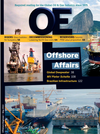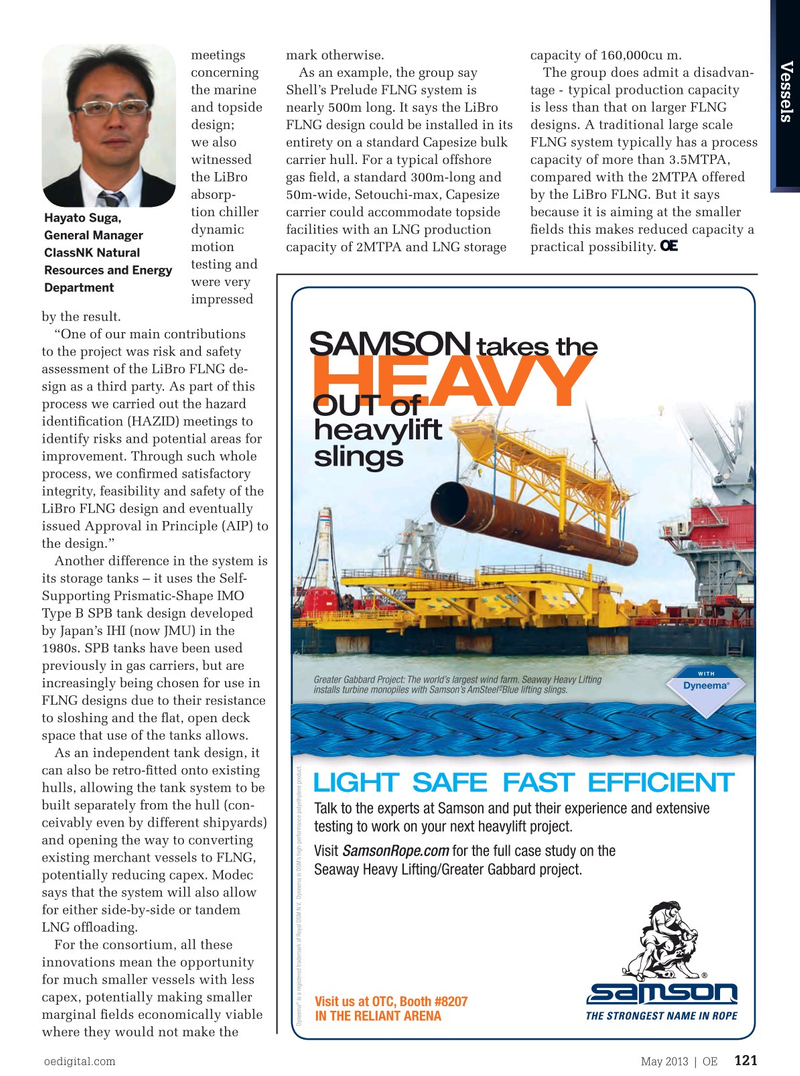
Page 119: of Offshore Engineer Magazine (May/Jun 2013)
Read this page in Pdf, Flash or Html5 edition of May/Jun 2013 Offshore Engineer Magazine
meetings mark otherwise. capacity of 160,000cu m.
Vessels concerning As an example, the group say The group does admit a disadvan- the marine Shell’s Prelude FLNG system is tage - typical production capacity and topside nearly 500m long. It says the LiBro is less than that on larger FLNG design; FLNG design could be installed in its designs. A traditional large scale we also entirety on a standard Capesize bulk FLNG system typically has a process witnessed carrier hull. For a typical offshore capacity of more than 3.5MTPA, the LiBro gas feld, a standard 300m-long and compared with the 2MTPA offered absorp- 50m-wide, Setouchi-max, Capesize by the LiBro FLNG. But it says tion chiller carrier could accommodate topside because it is aiming at the smaller
Hayato Suga, dynamic facilities with an LNG production felds this makes reduced capacity a
General Manager motion capacity of 2MTPA and LNG storage practical possibility.
ClassNK Natural testing and
Resources and Energy were very
Department impressed by the result.
“One of our main contributions
SamSon takes the to the project was risk and safety assessment of the LiBro FLNG de- sign as a third party. As part of this out of
HEAVY process we carried out the hazard identifcation (HAZID) meetings to heavylift identify risks and potential areas for improvement. Through such whole slings process, we confrmed satisfactory integrity, feasibility and safety of the
LiBro FLNG design and eventually issued Approval in Principle (AIP) to the design.”
Another difference in the system is its storage tanks – it uses the Self-
Supporting Prismatic-Shape IMO
Type B SPB tank design developed by Japan’s IHI (now JMU) in the 1980s. SPB tanks have been used previously in gas carriers, but are
Greater Gabbard Project: The world’s largest wind farm. Seaway Heavy Lifting increasingly being chosen for use in ® installs turbine monopiles with Samson’s AmSteel-Blue lifting slings.
FLNG designs due to their resistance to sloshing and the fat, open deck space that use of the tanks allows.
As an independent tank design, it can also be retro-ftted onto existing
LIGHt SaFE FaSt EFFICIEnt hulls, allowing the tank system to be built separately from the hull (con-
Talk to the experts at Samson and put their experience and extensive ceivably even by different shipyards) testing to work on your next heavylift project.
and opening the way to converting
Visit SamsonRope.com for the full case study on the existing merchant vessels to FLNG,
Seaway Heavy Lifting/Greater Gabbard project.
potentially reducing capex. Modec says that the system will also allow for either side-by-side or tandem
LNG offoading.
For the consortium, all these innovations mean the opportunity for much smaller vessels with less capex, potentially making smaller ®
Visit us at OTC, Booth #8207 marginal felds economically viable
IN THE RELIANT ARENA
Dyneema is a registered trademark of Royal DSM N.V. Dyneema is DSM’s high-performance polyethylene product.
where they would not make the oedigital.com May 2013 | OE 121
Vessels4-Libro.indd 121 4/22/13 7:27 PM

 118
118

 120
120